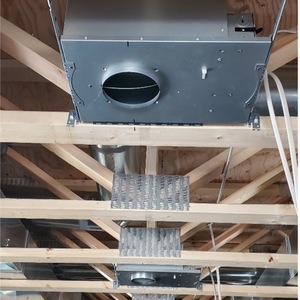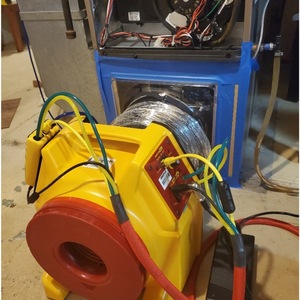
When it comes to houses, I’ve always believed that “small is beautiful.” All else being equal, a smaller house requires fewer materials to build and has a reduced visual and ecological footprint. Smaller houses also cost less to heat and cool and require fewer resources to maintain. For these reasons, building small is central to my green philosophy.
The market doesn’t seem to share my view. Between 1980 and 2022, the median size of a new house increased from 1595 sq. ft. to 2338 sq. ft. even as the median number of people per household fell. Increases in house size have offset efficiency gains from stricter codes mandating higher insulation levels and improved airtightness.
If we are going to build large houses, we need to make sure we hold them to standards at least as stringent as those for more modest homes. As I’ll explain below, the most commonly used metric for airtightness has inadvertently allowed larger homes to meet code with slipshod air-sealing. The 2021 edition of the International Energy Conservation Code, a model code on which many state and local codes are based, takes an important step toward fixing this “large house loophole.”
Role of the blower door
Air leakage is measured with a blower door, a large fan assembly set up in an exterior doorway. The fan blows air out of the house, depressurizing it to the standard test pressure of 50 pascals. The cubic feet per minute of airflow needed to maintain that 50-pascal pressure difference is recorded as the home’s “CFM50.” The higher the CFM50, the more and larger the air leaks in the house’s walls, ceilings, floors, windows, and doors.
Blower-door testing first appeared in the 2009 IECC as an optional alternative to a detailed visual inspection of the air barrier. The 2009 IECC and…
Weekly Newsletter
Get building science and energy efficiency advice, plus special offers, in your inbox.

This article is only available to GBA Prime Members
Sign up for a free trial and get instant access to this article as well as GBA’s complete library of premium articles and construction details.
Start Free TrialAlready a member? Log in















8 Comments
Interesting, thanks for the thorough overview Jon. It’s good to hear that standards are moving toward a consistent approach to air tightness and away from a volume bias.
A couple of things occur to me. And sorry for the long digression.
In terms of design, it’s hard to overstate the effect that performance metrics have on the shape of new buildings. Simple boxes are in, and bump outs, ells, and dormers are out for residential architecture. This has a radical effect on building design. And when performance and cost considerations are combined, those factors together will tend to favor multi family development over single family construction, as PHIUS clearly recognizes.
But buildings are bought and sold on the basis of an entirely different number than the ones we talk about, namely conditioned floor area. Volume and shell/envelope area are obscure and probably irrelevant to most people doing real estate. So it makes me wonder if there is a missed opportunity in not adopting a metric that considers leakiness/square foot of floor area?
In your example above, a 2400 ft2 building would simply have twice the cfm50 allowance as a 1200 ft2 building, which seems somehow intuitively sensible to me. I haven’t seen this discussed anywhere, so there may be arguments against that I am not seeing.
Still, this connects to an even bigger loophole than the surface-to-volume one: a sort of existing housing stock performance loophole. We have an obsessive and very detailed approach to new buildings in our little corner of the industry, but the building performance industry here in the US obviously struggles in relation to the enormity of the challenge of retrofitting existing buildings.
Some other countries have addressed this by, for example, applying performance metrics to existing building stock. In England for example, any building rented or sold must have an energy performance rating certificate.
If somehow real estate listings in this country included an efficiency rating, and as part of that, an easily understood air tightness rating, there would be much greater public awareness of building performance and efficiency, and maybe a better market for it. So I wonder if anyone is working on this?
These are all great points.
--Regarding CFM50/sf of floor space, I know that Nate Adams' "HVAC 2.0" group likes this exact metric as a quick and easy way to quantify leakiness. They refer to it as the "leakage ratio."
--My town, Ithaca NY, tried to promote a voluntary "Residential Energy Score" to report a home's energy performance at time of sale (https://www.town.ithaca.ny.us/resp/). It was an interesting project but never really got off the ground. Pearl Certification is a private company that provides certification for existing homes (https://pearlcertification.com/). It will be interesting to see if this makes an impact in the way energy efficiency is valued by the market.
I still can't get my head around the interpretation of R402.4.1.2.
If they meant 'and' but wrote 'or', how can 'or' function as an 'and'?
These are totally different operators.
If the IECC code committee wanted both air-tightness criteria to apply, wouldn't they have written an 'and' there?
For example:
The maximum air leakage rate for any building or dwelling unit under any compliance path shall not exceed 5.0 air changes per hour AND 0.28 cubic feet per minute (CFM) per square foot [0.0079 m3/(s × m2)] of dwelling unit enclosure area.
The inclusion of an 'AND' would ensure that both criteria apply, also ensuring that the more stringent one would too.
I work in a state which doesn't have IECC on the books, so I haven't read back into the original document to read deeper-- this just caught me while reading the article.
This section of the code could definitely have been written more clearly. I puzzled over it for a long time, and I think my interpretation is the most literal one. It became clearer for me when I thought of it in terms of luggage. The bag cannot exceed 18" or 50 lbs--if either parameter is exceeded, it's a no-go. You can say the same thing with "and"--the baggage must be less than or equal to 18" and 50 lbs. I am sure this question is going to come up frequently and may be subject to differing interpretations.
I have to agree that this creates a huge grey area that could be open to interpretation. In computer programming language, “or” and ”and” are distinct terms. “Or” means only one condition need be met, while “and” requires all conditions to be met. Everyday parlance is not the same as programming language, but the code is certainly worded ambiguously. Is there a mechanism to have this clarified before a new version of the international code is released?
The luggage example is an interesting one, I'm still churning overit and I think I can come around to your way of thinking, but I have to draw out a formal logic map using less formal code language. Regardless, I think there's still an argument that this is ambiguous.
Here's an example with the luggage-- is the statement
The bag cannot exceed OR[18", 50 lbs]
or is it
The bag cannot exceed 18"
or
the bag cannot exceed 50 lbs.
The question of or/and for R402.4.1.2 is best interpenetrated by asking the ICC.
You can ask for interpretation if you are a member.
So as a member I asked. Their response below. Even though the surface area criteria are for smaller units, they told me it would apply to any residence, not just small units.
Q: Do the two criteria (5.0 ACH and 0.28 cfm/ft²) mean it is an option or does it mean you need to meet both?
A: Section R402.4.1.2 states, “The maximum air leakage rate for any building or dwelling unit under any compliance path shall not exceed 5.0 air changes per hour or 0.28 cubic feet per minute (CFM) per square foot.” Section R402.4.1.2 provides two options for compliance since the two criteria ACH’s and cfm/ft² are separated by the conjunction “or”. Therefore, the use of the new cfm/ft² criterion is a choice that would be based upon design considerations.
The reason statement of RE92-19, which brought in the new provision, states, “ACH being a volumetric measurement penalized small volume dwelling units.” In other words, as dwelling units get smaller, achieving the air change per hour threshold becomes more difficult. The cfm/ft² option provides a normalized metric for air leakage through the surface area of the building thermal envelope (walls, roof and floors, as applicable), which will not create the small dwelling unit penalty.
Thanks for this. I will add a note to the article pointing to this clarification.
Log in or become a member to post a comment.
Sign up Log in